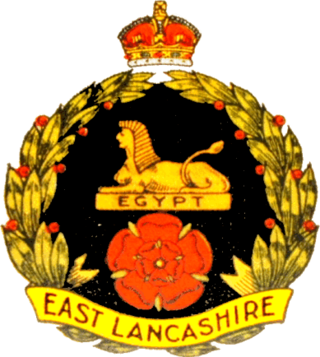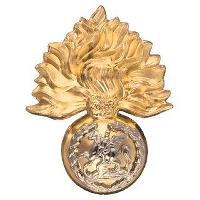Related Research Articles
The King's Regiment, officially abbreviated as KINGS, was an infantry regiment of the British Army, part of the King's Division. It was formed on 1 September 1958 by the amalgamation of the King's Regiment (Liverpool) which had been raised in 1685 and the Manchester Regiment which traced its history to 1758. In existence for almost 50 years, the regular battalion, 1 KINGS, served in Kenya, Kuwait, British Guiana (Guyana), West Germany, Northern Ireland, the Falkland Islands, Cyprus, and Iraq. Between 1972 and 1990, 15 Kingsmen died during military operations in Northern Ireland during a violent period in the province's history known as "The Troubles".
The Lancastrian and Cumbrian Volunteers was a Territorial Army unit of the British Army.

The King's Division is a British Army command, training and administrative apparatus designated for infantry regiments in the North of England.
The Lowland Brigade is a historical unit of the British Army which has been formed a number of times. It is traditionally Scottish as the name derives from the Scottish Lowlands.
The 1957 White Paper on Defence was a British white paper issued in March 1957 setting forth the perceived future of the British military. It had profound effects on all aspects of the defence industry but probably the most affected was the British aircraft industry. Duncan Sandys, the recently appointed Minister of Defence, produced the paper. The decisions were influenced by two major factors: the finances of the country and the coming of the missile age.

The East Lancashire Regiment was, from 1881 to 1958, a line infantry regiment of the British Army. The regiment was formed in 1881 under the Childers Reforms by the amalgamation of the 30th (Cambridgeshire) Regiment of Foot and 59th Regiment of Foot with the militia and rifle volunteer units of eastern Lancashire. In 1958 the regiment was amalgamated with the South Lancashire Regiment to form the Lancashire Regiment which was, in 1970, merged with the Loyal Regiment to form the Queen's Lancashire Regiment. In 2006, the Queen's Lancashire was further amalgamated with the King's Own Royal Border Regiment and the King's Regiment to form the present Duke of Lancaster's Regiment.
The Wessex Brigade was an administrative formation of the British Army from 1948 to 1968. The Brigade administered the regular infantry regiments of the Wessex area of south and south west England.
The Home Counties Brigade was an administrative formation of the British Army from 1948 to 1968. The Brigade administered the regular infantry regiments of the Home Counties of south east England.

The Fusilier Brigade was an administrative brigade of the British Army from 1958 to 1968, that administered the fusilier regiments.
The Yorkshire Brigade was an administrative brigade formation of the British Army from 1948 to 1968. The brigade administered the regular infantry regiments of Yorkshire, England.
The North Irish Brigade was a Brigade of the British Army which existed between 1948 and 1968; it consisted of the three regiments from Northern Ireland. After the Second World War there were 14 infantry depots in the United Kingdom, each bearing a letter. The depots were territorially aligned, and Infantry Depot M at Omagh was aligned with the regiments from Northern Ireland.

The Loyal Regiment (North Lancashire) (until 1921 known as the Loyal North Lancashire Regiment) was a line infantry regiment of the British Army that was in existence from 1881 to 1970. In 1970, the regiment was amalgamated with the Lancashire Regiment to form the Queen's Lancashire Regiment which was, in 2006, amalgamated with the King's Own Royal Border Regiment and the King's Regiment (Liverpool and Manchester) to form the Duke of Lancaster Regiment (King's, Lancashire and Border).
The 25th Division was an infantry division of the British Army, raised as part of Lord Kitchener's Third New Army (K3) in September 1914, shortly after the outbreak of the Great War. It served on the Western Front for most of the war.

The regimental depot of a regiment is its home base for recruiting and training. It is also where soldiers and officers awaiting discharge or postings are based and where injured soldiers return to full fitness after discharge from hospital before returning to full duty. Normally, a variety of regimental stores will also be kept at the depot. The regimental depot is not the same as the regimental headquarters, though in practice the two will often be co-located in the same place.
The 164th Brigade was an infantry brigade of the British Army that saw active service in the First World War as part of the 55th Division. As the 164th Infantry Brigade, it remained in the United Kingdom throughout the Second World War, as part of the 55th Infantry Division.
The Liverpool Brigade, later 165th (Liverpool) Brigade was an infantry brigade of Britain's Volunteer Force that served during World War I with the 55th Division of the British Army. During World War II, again as part of the 55th Infantry Division, the brigade remained in the United Kingdom.
The Lancashire Militia was an auxiliary military force in Lancashire in North West England. From their formal organisation as Trained Bands in 1558 and their service in the Williamite War in Ireland and against the Jacobite Risings, the Militia regiments of Lancashire served during times of international tension and all of Britain's major wars. They provided internal security and home defence but sometimes operated further afield, including Ireland and the Mediterranean, relieving regular troops from routine garrison duties, and acting as a source of trained officers and men for the Regular Army. All the infantry battalions went on active service during the Second Boer War and all served as Special Reserve training units in World War I, with one battalion seeing considerable action on the Western Front. After 1921 the militia had only a shadowy existence until its final abolition in 1953.
The Lancastrian Volunteers was a short lived Territorial Army infantry regiment of the British Army, composed of companies from the North West affiliated regiments.

The Highland Brigade was an administrative brigade of the British Army from 1946 to 1968, that administered the regiments with recruiting grounds in the Scottish Highlands.
References
- ↑ Messenger, Charles (16 March 1994). A History of British Infantry: For Love of Regiment, Volume 2, 1915-1994. p. 156. ISBN 9780850524222.
- ↑ Whitaker's Almanack 1956, p. 471
- ↑ "Infantry Brigade Depots (Location)". Parliamentary Debates (Hansard) . 7 March 1958. Retrieved 10 April 2014.
- ↑ Whitaker's Almanack 1969, p. 473